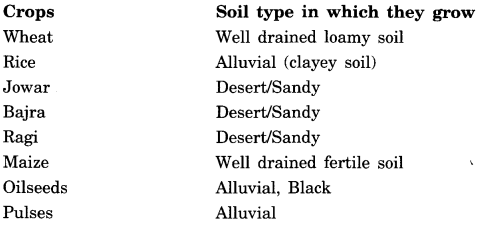Chapter 4 Agriculture
Class 8 Social Science (Geography)
EXERCISE
1. Answer the following questions.
Question 1(1). What is agriculture?
Answer: Agriculture is the primary activity which includes growing of crops, fruits, vegetables, flowers, and the rearing of livestock.
Question 1(2). Name the factors influencing agriculture?
Answer: Factors influencing agriculture:
Favourable topography.
Soil
Climate
Irrigation
Question 1(3). What is Shifting cultivation? What are its disadvantages?
Answer: Shifting cultivation is the form of agriculture in which a plot of land is cleared by felling the trees and burning them. The ashes are then mixed with soil and crops are grown. After some time, the land is abandoned and the farmers move to a different place. It is disadvantageous because it involves deforestation and the burning of trees. Thus it is not good for the environment.
Question 1(4). What is plantation agriculture?
Answer: Plantation agriculture is a type of commercial agriculture:
It is a single crop farming which resembles factory production,
Large amount of labour and capital is required.
The produce may be processed on the farm itself or in factories.
Crops like banana, rubber, tea, coffee etc. are grown on plantations.
Question 1(5). Name the fiber crops and name the climatic conditions required for their growth.
Answer: The two fibre crops are cotton and jute. The conditions required for their cultivation
Cotton
It requires high temperature.
Light rainfall, 210 frost free days, bright sunshine for its growth.
Grows well in black and alluvial soil.
Area of cultivation: China, USA India, Pakistan, Brazil and Egypt.
Jute
High temperature required.
Heavy rainfall.
Grows well in alluvial soils.
Areas of production: India and Bangladesh.
Question 2. Tick the correct answer.
(1) Horticulture means
(a) growing of fruits and vegetables
(b) primitive farming
(c) growing of wheat
(2) Golden fiber refers to
(a) tea
(b) cotton
(c) jute
(3) Leading producers of coffee
(a) Brazil
(b) India
(c) Russia
Question 3(1). Give reasons of the following.
In India, agriculture is a primary activity.
Answer: In India agriculture is a primary activity because:
Of its tropical climate and topography which is suitable for cultivation.
More than 60% of the population is dependent on it.
Needs food security for feeding millions.
Question 3(2). Different crops are grown in different regions because of the following reasons:
Answer: The growth of crops depends on a lot of factors. Climate, rainfall, humidity, etc are important factors. In absence of certain conditions, it may not be possible to grow a certain crop. So, different crops are grown in different regions.
Question 4. Distinguish between the following.
(1) Primary activities and tertiary activities.
(2) Subsistence farming and intensive farming.
Answer: (1) Distinction between Primary Activities and Tertiary Activities.
Primary Activities
1. Primary activities are those activities in which natural resources are obtained.
2. Examples: Extraction, hunting, mining, gathering, agriculture, fishing and rearing of livestock.
Tertiary Activities
1. Tertiary activities are those activities which provide support to primary and secondary sectors.
2. Examples: Transport, communication, trade, banking, insurance, and advertising.
(2) Distinction between subsistence and Intensive Farming.
Intensive farming is a part of subsistence farming. So both have a little difference. Still, some differences are:
Answer: Subsistence Farming
1. subsistence farming is the type of farming practice in which the farmer raises agriculture crops for himself and his family.
2. Household labour is used.
3. Subsistence farming is done on a traditional basis by traditional tools and implements.
4. Production is meant for their own family only.
Intensive Farming
1. Intensive farming is an agricultural practice in which efforts are made to increase production with added units of labour and capital and raise two to three crops in a year.
2. Outside labour is hired.
3. Extra tools may be hired.
4. Production is primarily meant for domestic consumption. Excess is sold in the market.
5. Activity Question 5 (1). Collect seeds of wheat, rice, jowar, bajra, ragi, maize, oilseeds, and pulses available in the market. Bring them to the class and find out which type of soil they grow.
Answer: Collect the seeds of wheat, rice, jowar, bajra, ragi, maize, oilseeds, and pulses available in the market yourself and bring them to the class.
Question 5(2). Find out the differences between the lifestyle of farmers in the USA and India on the basis of pictures collected from magazines, books, newspapers, and the internet.
Answer:
| Criteria | Farm in India | Farm in the USA |
| Average size | 1.5 Hectares. | 250 Hectares. |
| Land tenure | Tenancy, sharecropping fragmentation due to hereditary. | Freehold ownership. |
Environment issues | Use of fertilizers, HYV seeds and irrigation. | Physical factors are less important. |
| Soil | Generally fertile gives two to three crops a year, use traditional knowledge. | Regular soil testing for nutrient deficiency. |
| Crops | Mainly food Crops along with other related activities. Wheat, rice, millets etc. | Specialized farming like com, soya bean, wheat, cotton etc. |
| Operations | Lack of use of scientific technology, machines, more of manual power. | Use of latest technical knowledge and satellite for information. |
Economic | Lack of good transport, communication or even storage facilities, poor farmers. | Better facilities and prosperous farmers. |
| Human factors | Work as farm labour, many dependent on this activity. | Work as a business person, not as a farmer. |
अध्याय 4 कृषि
1. निम्नलिखित प्रश्नों के उत्तर दीजिए।
प्रश्न 2. सही उत्तर पर टिक करें।


